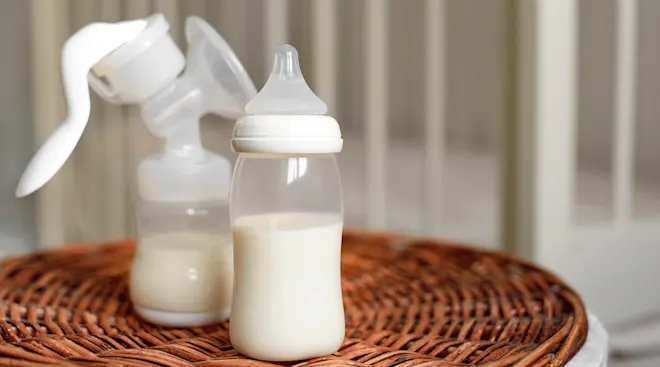Top 10 Breastfeeding Problems Solved
Breastfeeding may be natural, but it’s not always easy. The truth is, there are several things that can pop up along your nursing journey, throwing up roadblocks on what might already be a pretty bumpy road. What is easy? Getting great advice from the experts that know breasts and babies best. We asked them for their best tips for how to handle the most common breastfeeding problems new moms face. Here’s what they said.
Real talk: It’s 100 percent normal for your nipples to feel a little (or a lot) sore when you first start breastfeeding, especially if you’re a first-timer. But if the pain lasts longer than a few seconds into your feeding session, there may be an issue with baby’s latch. Remember, both you and baby are learning the ropes here, so an improper latch is one of the most common breastfeeding problems to surface.
Solution: First, gently rub your nipple under baby’s nose to encourage a wide-open mouth. “Most babies will ‘root’ at the breast and give you a good, open mouth when they’re ready to nurse,” says Stephanie Nguyen, RN, IBCLC, a lactation consultant and founder of Modern Milk, a breastfeeding clinic and prenatal-postnatal education center in Scottsdale, Arizona. “Next, place baby so their bottom lip is positioned well below your nipple, not at the base of the nipple,” she adds. “But be sure to bring baby onto your breast, rather than putting your breast in their mouth.” You’ll know baby is positioned correctly when their chin touches your breast, their lips are splayed out and you can’t see your nipple or part of the lower areola. (For more latching how-to, check out our latching guide.)
This is one of those breastfeeding problems that can be the result of many different things: a shallow latch, pumping improperly, thrush and sometimes even dry skin. During your first week of breastfeeding, when baby is just learning to latch, you may even experience some bloody discharge, says Jane Morton, MD, a clinical professor of pediatrics emerita at Stanford Medical Center in Palo Alto, California, and founder of Droplet, an online resource for breastfeeding moms. Cracked nipples might be a little frightening (and uncomfortable), but this breastfeeding problem is nothing to worry about.
Solution: Your first step is to make sure baby is properly positioned. “When baby has a shallow latch, your nipple is positioned in the front of baby’s mouth, which means your nipple is rubbing along baby’s hard palate,” says Nguyen. Once you get a deeper latch, your nipple settles farther back in baby’s mouth where the soft palate lies, which is a much more comfortable (and effective) latch. It’s always best to have an OB or lactation consultant determine the cause of your cracked nipples before jumping into treatment, but for many moms, soothing gel pads, nursing ointments and/or taking a mild painkiller like acetaminophen (Tylenol) 30 minutes before nursing can help ease discomfort. Morton also suggests letting some milk stay on your nipples after a feeding and air dry to aid healing. And because cracked nipples can allow for bacteria to enter the breast, wash your sore nipples with soap and water at least twice a day. (For even more on how to heal your cracked nipples, see our primer.)
Engorged breasts (aka breasts bulging with a whole lot of milk) are very full, firm and taut, making it hard for baby to latch—and yes, like so many breastfeeding problems, engorged breasts can be pretty uncomfortable for mom. Your breasts may become engorged at the beginning of your breastfeeding journey when your milk first comes in and your body is still figuring out how to regulate milk production. Engorgement can also happen if you go too long between feedings or if baby isn’t properly draining your breasts of milk.
Solution: Try hand-expressing a little before feeding baby. This will get the milk flowing and soften the breast, making it easier for baby to latch and access milk, says Morton. Of course, the more you nurse, the less likely your breasts are to get engorged. (For more tips on relieving engorgement, read our guide on how to find relief.)
Check out The Bump’s Breastfeeding Solutions chart:
When your breasts are overly full or you’ve gone longer than usual between feeds, milk can back up into your ducts, clogging them up. You’ll know you’ve got a plugged duct if there’s a hard lump on your breast, if your breast is sore to the touch, and/or there’s some redness. If you’ve got a fever too, that’s a sign of mastitis (see blow). Other causes of clogged ducts include: Compressing your breasts while sleeping; using wrong-sized pumping parts or an inefficient pump or having something hit your breast in the same spot, like the underwire of your bra. “But some women are simply more prone to plugged ducts and there may not actually be an underlying cause,” says Nguyen.
Solution: For clogged milk ducts, Morton encourages getting adequate rest (you should recruit your partner to pick up some slack when possible). You can also try feeding baby on the affected side first at each feeding until the duct is cleared. Applying warm compresses to your breasts and massaging them can also help break up the clog. “Vibration works too,” says Nguyen. “Try an electric massager or the end of an electric toothbrush.”
Mastitis is a bacterial infection in your breasts marked by flu-like symptoms such as fever and pain in your breasts, Morton says. It’s common within the first few weeks after birth (though it can also happen anytime during breastfeeding) and may be caused by other breastfeeding problems, such as clogged milk ducts, engorgement or even cracked nipples, which can allow bacteria to enter the breast, causing the infection.
Solution: The only way to treat mastitis is with antibiotics. “Your OB will make sure to prescribe one that’s safe and compatible with breastfeeding,” says Nguyen, who also recommends adding a probiotic to your daily routine whenever antibiotics are being used. At the same time, it’s still important to frequently empty your breasts. “If it’s too painful to nurse or baby refuses to nurse, pump to keep your breasts empty,” says Nguyen. “Milk backing up in your breasts can make mastitis worse.” Finally, warm compresses can help soothe discomfort.
Thrush is a yeast infection in baby’s mouth, which can spread to your breasts. You’ll notice red, shiny and sometimes flaky nipples. You may also experience an itching sensation or deep, shooting breast pain.
Solution: Your doctor will need to prescribe an antifungal medication to put on your nipple and in baby’s mouth (OTC meds don’t cut it here). If you and baby are not both treated at the same time, you can easily pass the fungi back and forth, prolonging the healing, says Morton. To keep the yeast contained, make sure to sanitize all pump parts that come in contact with your breasts. “You’ll also want to wash all bras, clothing and nursing pads daily in hot water and vinegar to kill any yeast spores,” says Nguyen.
In theory, breastfeeding is a supply-and-demand system. The more you nurse or pump, the more milk your body should make. That said, there can be many reasons for a low milk supply, so it’s always best to consult a lactation consultant to see what’s going on.
Solution: Frequent nursing and pumping during the day can help up your breast milk supply. While it’s important to stay hydrated and well nourished when nursing, surprisingly, downing an excess of fluids and consuming more calories hasn’t been shown to increase milk production, Morton notes. For more in-depth info on upping your supply, see more pro tips here.
Newborns can be especially sleepy in the first few weeks after birth, so nodding off while nursing is common—and even expected. However, snoozing at the breast can also occur if baby isn’t getting enough breast milk. “Milk flowing throughout the feeding will keep baby awake and engaged,” says Nguyen.
Solution: Milk flow is always fastest at the start at a feed, with the first let-down. So if you’re looking to increase efficiency, start with the fuller breast, then switch to the other sooner rather than later, Morton says. When baby’s sucking slows and their eyes are fluttering, massage your breast with your free hand. “Oftentimes, this will get milk flowing and perk baby up,” says Nguyen. “You can also try rubbing baby’s head, blowing gently in their face and gently shifting their position to wake her up.” Undressing your little one or even running a wet wipe down their cheek may also help.
Unsure about the state of your nipples? Gently pinch your areola with your thumb and index finger. If your nipple retracts rather than protrudes, you may have inverted nipples. But take heart: Having flat or inverted nipples doesn’t mean you won’t be able to breastfeed. However, “it does mean that you’d likely benefit from some latching assistance with a lactation consultant,” says Nguyen.
Solution: In addition to getting some pro help, you can use a breast pump to get your milk flowing and pull your nipples out as much as possible before placing baby at your breast for a feed. You might also consider using nipple shields. “Nipple shields are thin, silicone shields that fit over the nipple that help the nipple protrude more, which makes latching easier,” says Nguyen. A lactation consultant can show you how to use them and make sure they’re fitting you properly so they don’t lead to other breastfeeding problems.
The milk let-down sensation (aka “milk ejection reflex”) is often experienced as a tingling or a prickly pins-and-needles kind of feeling. But for some, the sensation is felt deep in the breasts and can hurt or be achy, especially when milk production is in overdrive.
Solution: When this pain develops due to an excessive amount of milk, try feeding baby longer on one particular breast and switching to the other only if you need to. However, if your prickly feeling morphs into more of a tiny-daggers-poking-your-breasts feeling, visit your healthcare provider. You may actually be experiencing a yeast or bacterial infection in your breasts. If you’ve got a fever, aches and chills, those are big red flags and call for treatment.
Expert bios:
Stephanie Nguyen, RN, MSN, WHNP-C, IBCLC, is a registered nurse, women’s health nurse practitioner and lactation consultant. She’s also the founder of Modern Milk, a breastfeeding clinic and prenatal-postnatal education center in Scottsdale, Arizona. She has a Master of Science degree in nursing from The University of Cincinnati and previously worked as a postpartum and labor/delivery nurse.
Jane Morton, MD, FABM, FAAP, is a pediatrician and international expert on breastfeeding. She is a clinical professor of pediatrics emerita at Stanford Medical Center in Palo Alto, California, and previously served as the director of the breastfeeding medicine program at Stanford University, as well as an executive board member of the American Academy of Pediatrics’ Section on Breastfeeding. She is also the founder of Droplet, an online resource for breastfeeding moms.
Please note: The Bump and the materials and information it contains are not intended to, and do not constitute, medical or other health advice or diagnosis and should not be used as such. You should always consult with a qualified physician or health professional about your specific circumstances.
Plus, more from The Bump:
Navigate forward to interact with the calendar and select a date. Press the question mark key to get the keyboard shortcuts for changing dates.





















































